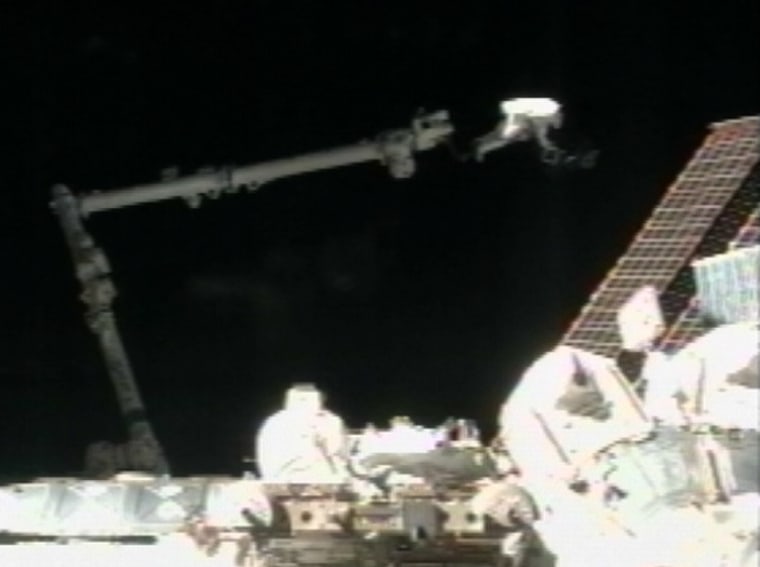NASA conducted a swift series of tests on the ground Monday to determine whether spacewalking astronauts need to fix a deep gouge in Endeavour’s belly for re-entry, and assembled a special team to weigh the repair options.
The gouge is relatively small — 3.5 inches by 2 inches (9 by 5 centimeters) — but part of it penetrates through the protective thermal tiles, leaving just a thin layer of coated felt over the space shuttle’s aluminum frame to keep out the more than 2,000-degree Fahrenheit (1,100-degree Celsius) heat of re-entry. The exposed area is 1 inch (2.54 centimeters) long and less than a quarter-inch (6 millimeters) wide.
Mission managers expect to decide by Wednesday whether astronauts should go out and patch the gouge. The damage is benign enough for Endeavour to fly safely home; it’s more a matter of avoiding extensive post-flight repairs to any possible structural damage, said John Shannon, chairman of the mission management team.
“This is not a 'catastrophic loss of orbiter' case at all. This is a case where you want to do the prudent thing for the vehicle,” Shannon told reporters Monday evening.
NASA has never attempted this type of repair on an orbiting shuttle, and two of the three remedies — all developed following Columbia’s catastrophic re-entry — are untested in space.
Engineers are uncertain whether it was foam insulation that came off Endeavour’s external fuel tank and struck the shuttle at liftoff, as was the case for Columbia four years ago, or whether the debris was ice or a combination of materials, Shannon said.
Despite extensive redesigning of the shuttle fuel tank that has already cost NASA a few hundred million dollars, foam has repeatedly fallen off the tank during launch, although nothing nearly as big as the piece that crippled Columbia.
Depending on how NASA addresses the latest problem, space shuttle flights could possibly come to a temporary halt, stalling construction at the international space station once more. Foam problems have caused two lengthy holddowns.
How the fix would be made
To patch the gouge, spacewalking astronauts would have to perch on the end of the shuttle’s 100-foot (30-meter) robotic arm and extension boom, be maneuvered under the spacecraft, and apply black paint and possibly squirt in goo, as well.
The black coating, intended to help dissipate heat, was tested on a previous shuttle flight. The caulklike goo has been tested in vacuum chambers on Earth, but never in space. A third option, a screw-on panel that’s intended for bigger damage, was ruled out late Monday.
“This is kind of a pain to have to go and run all these assessments. It’s kind of a pain if I have to get the vehicle, get somebody under the vehicle and put a little squirt of goo,” Shannon said. But three or four hours of spacewalk repairs would be preferable to 12 weeks of inspection and repairs to Endeavour because of re-entry heat damage, he noted.
Shannon said the fact that the space shuttles are slated to retire in 2010, and the space station needs to be completed by then, did not enter the discussions.
Gyroscope replaced on station
A 6.5-hour spacewalk by two of Endeavour’s astronauts Monday, meanwhile, was comparatively routine.
Astronauts Rich Mastracchio and Dave Williams ventured outside for the second time in three days, removing a 600-plus-pound (300-kilogram) gyroscope from the space station’s exterior that failed last October. They installed a new one in its place that was carried up aboard Endeavour. The space station has four gyroscopes to keep it steady and pointed in the right direction.

Teacher-astronaut Barbara Morgan — Christa McAuliffe’s backup for Challenger’s doomed mission in 1986 — helped monitor the spacewalk from inside the joined shuttle-station complex.
Even before Endeavour’s liftoff, NASA was planning a third spacewalk for Wednesday and a fourth for Friday to carry out more space station work. Any shuttle repairs, if ordered, would take place on the fourth outing.
The shuttle isn’t due to leave the station until next Monday; landing is set for Aug. 22.
How the damage was done
The damage occurred a minute after liftoff last week when a baseball-sized piece of debris broke off a bracket on the external fuel tank, bounced off a strut farther down on the tank, then slammed into Endeavour’s belly. It’s also possible part of the strut broke off when the debris hit it, and that’s what may have shot into Endeavour, Shannon said.
By comparison, the chunk of foam that carved a 6-inch to 10-inch (15- to 25-centimeter) hole in Columbia’s left wing back in 2003 was the size of a small carry-on suitcase.
The speed at which the debris broke off Endeavour’s tank — 300 feet per second (90 meters per second) — is puzzling if it was solely foam, Shannon said. Experts assumed foam would have shattered going that fast and not remained intact and then hit the shuttle, he noted.
The brackets that hold the liquid oxygen feed line to the tank are particularly troublesome. NASA is switching from foam-covered aluminum alloy brackets to titanium ones that would require hardly any foam, but not until next spring. That leaves three more shuttle launches at risk for shedding bracket foam.
Shannon stressed Sunday — and again Monday — that there will always be some risk of launch debris, no matter how many improvements.
“The risk is not zero and we have known that from day one,” he said.